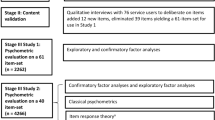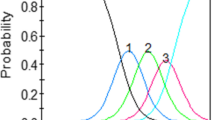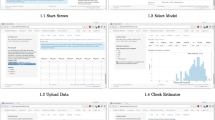Abstract
Purpose
There is growing interest in the use of item response theory (IRT) for creation of measures of health-related quality of life (HRQOL). A first step in IRT modeling is development of item banks. Our aim is to describe the value of including librarians and to describe processes used by librarians, in the creation of such banks.
Method
Working collaboratively with PROMIS researchers at the University of Pittsburgh, a team of librarians designed and implemented comprehensive literature searches in a selected set of information resources, for the purpose of identifying existing measures of patient-reported emotional distress.
Results
A step-by-step search protocol developed by librarians produced a set of 525 keywords and controlled vocabulary terms for use in search statements in 3 bibliographic databases. These searches produced 6,169 literature citations, allowing investigators to add 444 measurement scales to their item banks.
Conclusion
Inclusion of librarians on the Pittsburgh PROMIS research team allowed investigators to create large initial item banks, increasing the likelihood that the banks would attain high measurement precision during subsequent psychometric analyses. In addition, a comprehensive literature search protocol was developed that can now serve as a guide for other investigators in the creation of IRT item banks.



Similar content being viewed by others
References
Reeve, B. B., Hays, R. D., Chang, C. H., & Perfetto, E. M. (2007). Applying item response theory to enhance health outcomes assessment. Quality of Life Research, 16(Suppl 1), 1–3. doi:10.1007/s11136-007-9220-6.
Chang, C. H. (2007). Patient-reported outcomes measurement and management with innovative methodologies and technologies. Quality of Life Research, 16(Suppl 1), 157–166. doi:10.1007/s11136-007-9196-2.
Hays, R. D., & Lipscomb, J. (2007). Next steps for use of item response theory in the assessment of health outcomes. Quality of Life Research, 16(Suppl 1), 195–199. doi:10.1007/s11136-007-9175-7.
Cella, D., Yount, S., Rothrock, N., Gershon, R., Cook, K., Reeve, B., et al. (2007). The patient-reported outcomes measurement information system (PROMIS): Progress of an NIH roadmap cooperative group during its first two years. Medical Care, 45((5, Suppl 1)), S3–S11. doi:10.1097/01.mlr.0000258615.42478.55.
Bjorner, J. B., Chang, C. H., Thissen, D., & Reeve, B. B. (2007). Developing tailored instruments: Item banking and computeraized adaptive assessment. Quality of Life Research, 16(Suppl 1), 95–108. doi:10.1007/s11136-007-9168-6.
Revicki, D. A., & Cella, D. F. (1997). Health status assessment for the twenty-first century: Item response theory, item banking and computer adaptive testing. Quality of Life Research, 6(6), 595–600. doi:10.1023/A:1018420418455.
Cook, K. F., Teal, C. R., Bjorner, J. B., Cella, D., Chang, C. H., Crane, P. K., et al. (2007). IRT health outcomes data analysis project: An overview and summary. Quality of Life Research, 16(Suppl 1), 121–132. doi:10.1007/s11136-007-9177-5.
Fries, J. F., Bruce, B., & Cella, D. (2005). The promise of PROMIS: Using item response theory to improve assessment of patient-reported outcomes. Clinical and Experimental Rheumatology, 23(5, Suppl 39), S53–S57.
Medical Library Association. (2005). Role of expert searching in health sciences libraries. Journal of the Medical Library Association: JMLA, 93(1), 42–44.
Davidoff, F., & Florance, V. (2000). The informationist: A new health profession? Annals of Internal Medicine, 132(12), 996–998.
Lefebvre, C., Manheimer, E., & Glanville, J. (2008). Chapter 6: Searching for studies. In J. P. T. Higgins & S. Green (Eds.), Cochrane handbook for systematic reviews of interventions (pp. 95–150). England: Wiley.
Delaney, A., Bagshaw, S. M., Ferland, A., Laupland, K., Manns, B., & Doig, C. (2007). The quality of reports of critical care meta-analyses in the Cochrane database of systematic reviews: An independent appraisal. Critical Care Medicine, 35(2), 589–594. doi:10.1097/01.CCM.0000253394.15628.FD.
Glenny, A., Esposito, M., Coulthard, P., & Worthington, H. (2003). The assessment of systematic reviews in dentistry. European Journal of Oral Sciences, 111(2), 85–92. doi:10.1034/j.1600-0722.2003.00013.x.
Kelly, K., Travers, A., Dorgan, M., Slater, L., & Rowe, B. (2001). Evaluating the quality of systematic reviews in the emergency medicine literature. Annals of Emergency Medicine, 38(5), 518–526. doi:10.1067/mem.2001.115881.
Moher, D., Soeken, K., Sampson, M., Ben-Porat, L., & Berman, B. (2002). Assessing the quality of reports of systematic reviews in pediatric complementary and alternative medicine. BMC Pediatrics, 2, 3. doi:10.1186/1471-2431-2-3.
Mokkink, L. B., Terwee, C. B., Stratford, P. W., Alonso, J., Patrick, D. L., Riphagen, I., et al. (2009). Evaluation of the methodological quality of systematic reviews of health status measurement instruments. Quality of Life Research, 18(3), 313–333. doi:10.1007/s11136-009-9451-9.
Golder, S., Loke, Y., & McIntosh, H. M. (2008). Poor reporting and inadequate searches were apparent in systematic reviews of adverse effects. Journal of Clinical Epidemiology, 61(5), 440–448. doi:10.1016/j.jclinepi.2007.06.005.
Sampson, M., Barrowman, N. J., Moher, D., Klassen, T. P., Pham, B., Platt, R., et al. (2003). Should meta-analysts search Embase in addition to Medline? Journal of Clinical Epidemiology, 56(10), 943–955. doi:10.1016/S0895-4356(03)00110-0.
Bellack, A. S., & Hersen, M. (1998). Behavioral assessment: A practical handbook (4th ed.). Boston: Allyn and Bacon.
Knapp, S. D. (2000). The contemporary thesaurus of search terms and synonyms: A guide for natural language computer searching (2nd ed.). Phoenix, Ariz.: Oryx Press.
Radloff, L. S. (1977). The CES-D Scale: A self-report depression scale for research in the general population. Applied Psychological Measurement, 1(3), 385–401. doi:10.1177/014662167700100306.
Pilkonis, P. A. (2006). Item identification and pooling. Inaugural PROMIS Conference; Gaithersburg, MD.
Ward, D., Meadows, S. E., & Nashelsky, J. E. (2005). The role of expert searching in the family physicians’ inquiries network (FPIN). Journal of the Medical Library Association: JMLA, 93(1), 88–96.
Acknowledgments
The Patient-Reported Outcomes Measurement Information System (PROMIS) is a National Institutes of Health (NIH) Roadmap Initiative to develop a computerized system measuring patient-reported outcomes in respondents with a wide range of chronic diseases and demographic characteristics. PROMIS was funded by cooperative agreements to a Statistical Coordinating Center (Evanston Northwestern Healthcare, PI: David Cella, PhD, U01AR52177) and six Primary Research Sites (Duke University, PI: Kevin Weinfurt, PhD, U01AR52186; University of North Carolina, PI: Darren DeWalt, MD, MPH, U01AR52181; University of Pittsburgh, PI: Paul A. Pilkonis, PhD, U01AR52155; Stanford University, PI: James Fries, MD, U01AR52158; Stony Brook University, PI: Arthur Stone, PhD, U01AR52170; and University of Washington, PI: Dagmar Amtmann, PhD, U01AR52171). NIH Science Officers on this project are Deborah Ader, Ph.D., Susan Czajkowski, PhD, Lawrence Fine, MD, DrPH, Laura Lee Johnson, PhD, Louis Quatrano, PhD, Bryce Reeve, PhD, William Riley, PhD, Susana Serrate-Sztein, MD, and James Witter, MD, PhD. See the web site at www.nihpromis.org for additional information on the PROMIS cooperative group. We would like to acknowledge the contributions of all Pittsburgh PROMIS co-investigators and staff.
Author information
Authors and Affiliations
Corresponding author
Rights and permissions
About this article
Cite this article
Klem, M., Saghafi, E., Abromitis, R. et al. Building PROMIS item banks: librarians as co-investigators. Qual Life Res 18, 881–888 (2009). https://doi.org/10.1007/s11136-009-9498-7
Received:
Accepted:
Published:
Issue Date:
DOI: https://doi.org/10.1007/s11136-009-9498-7




